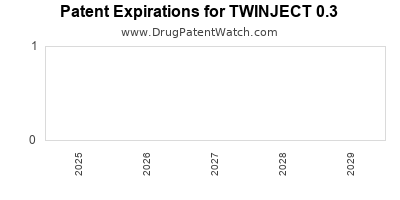TWINJECT 0.3 Drug Patent Profile
✉ Email this page to a colleague
Which patents cover Twinject 0.3, and when can generic versions of Twinject 0.3 launch?
Twinject 0.3 is a drug marketed by Impax and is included in one NDA.
The generic ingredient in TWINJECT 0.3 is epinephrine. There are twenty-one drug master file entries for this compound. Twenty-one suppliers are listed for this compound. Additional details are available on the epinephrine profile page.
DrugPatentWatch® Litigation and Generic Entry Outlook for Twinject 0.3
A generic version of TWINJECT 0.3 was approved as epinephrine by BPI LABS on July 29th, 2014.
AI Research Assistant
Questions you can ask:
- What is the 5 year forecast for TWINJECT 0.3?
- What are the global sales for TWINJECT 0.3?
- What is Average Wholesale Price for TWINJECT 0.3?
Summary for TWINJECT 0.3
| US Patents: | 0 |
| Applicants: | 1 |
| NDAs: | 1 |
| Finished Product Suppliers / Packagers: | 5 |
| Raw Ingredient (Bulk) Api Vendors: | 60 |
| Clinical Trials: | 1 |
| Patent Applications: | 1,923 |
| Formulation / Manufacturing: | see details |
| DailyMed Link: | TWINJECT 0.3 at DailyMed |

Recent Clinical Trials for TWINJECT 0.3
Identify potential brand extensions & 505(b)(2) entrants
| Sponsor | Phase |
|---|---|
| University of Louisville | Phase 4 |
| Arthroplasty Foundation, Inc. | Phase 4 |
US Patents and Regulatory Information for TWINJECT 0.3
| Applicant | Tradename | Generic Name | Dosage | NDA | Approval Date | TE | Type | RLD | RS | Patent No. | Patent Expiration | Product | Substance | Delist Req. | Exclusivity Expiration |
|---|---|---|---|---|---|---|---|---|---|---|---|---|---|---|---|
| Impax | TWINJECT 0.3 | epinephrine | INJECTABLE;INTRAMUSCULAR, SUBCUTANEOUS | 020800-001 | May 30, 2003 | DISCN | No | No | ⤷ Sign Up | ⤷ Sign Up | ⤷ Sign Up | ||||
| >Applicant | >Tradename | >Generic Name | >Dosage | >NDA | >Approval Date | >TE | >Type | >RLD | >RS | >Patent No. | >Patent Expiration | >Product | >Substance | >Delist Req. | >Exclusivity Expiration |
International Patents for TWINJECT 0.3
See the table below for patents covering TWINJECT 0.3 around the world.
| Country | Patent Number | Title | Estimated Expiration |
|---|---|---|---|
| Australia | 1994295 | ⤷ Sign Up | |
| Japan | 5138811 | ⤷ Sign Up | |
| China | 101072595 | Medicine injection devices and methods | ⤷ Sign Up |
| San Marino | AP200700023 | Dispositivi e metodi per iniezioni di medicinali | ⤷ Sign Up |
| Austria | 213424 | ⤷ Sign Up | |
| >Country | >Patent Number | >Title | >Estimated Expiration |
Make Better Decisions: Try a trial or see plans & pricing
Drugs may be covered by multiple patents or regulatory protections. All trademarks and applicant names are the property of their respective owners or licensors. Although great care is taken in the proper and correct provision of this service, thinkBiotech LLC does not accept any responsibility for possible consequences of errors or omissions in the provided data. The data presented herein is for information purposes only. There is no warranty that the data contained herein is error free. thinkBiotech performs no independent verification of facts as provided by public sources nor are attempts made to provide legal or investing advice. Any reliance on data provided herein is done solely at the discretion of the user. Users of this service are advised to seek professional advice and independent confirmation before considering acting on any of the provided information. thinkBiotech LLC reserves the right to amend, extend or withdraw any part or all of the offered service without notice.


